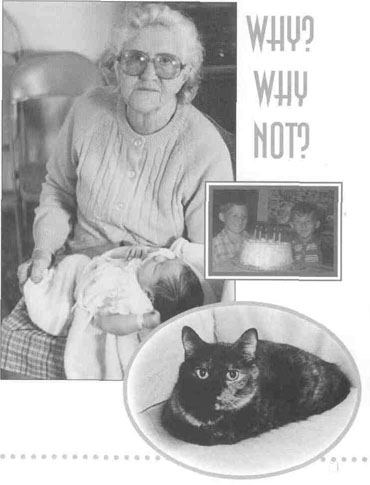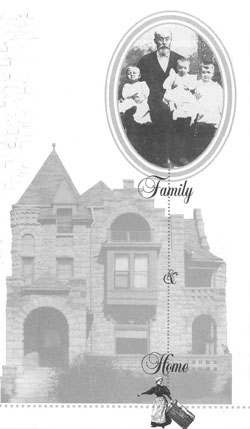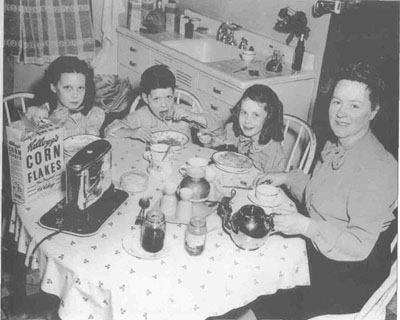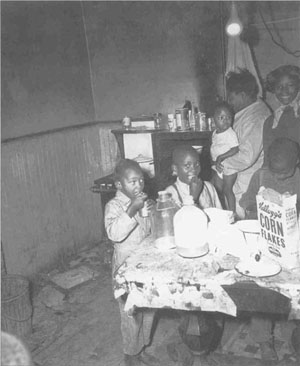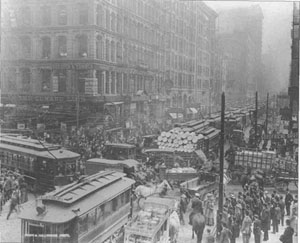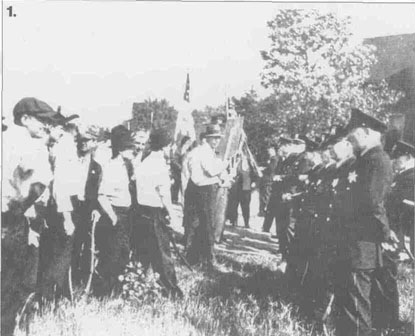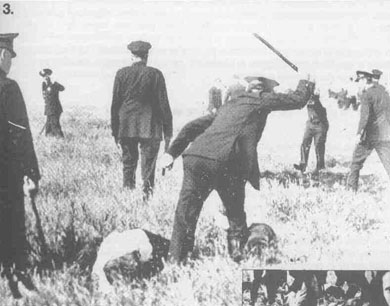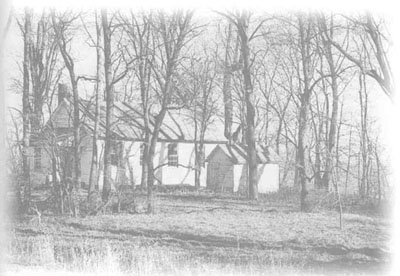C U R R I C U L U M M A T E R I A L S
|
Rod Sellers
Overview
Main Ideas
Photographs are primary source documents and a rich source of information for
history students. In addition, there are
numerous sources of historical photographs
that are accessible to students and may be
used in a variety of interesting ways. Among
those often overlooked sources are family
photographs and photographs of local communities available in local community historical museums or in the archives of local
newspapers.
Connection with the Curriculum
Analysis of photographs may be used in
any social studies discipline for which historical photographs are available. Also, many
of the techniques and activities may be
adapted for use with any visual primary
source material, such as posters, political
cartoons, and works of art.
Teaching Level
Grades 7-12
Materials for Each Student
• Sample historical photographs
• Activity sheets
• Magnifying glass (optional)
Objectives for Each Student
• Improve analytical and perceptual
skills through systematic analysis
of photographs.
• Distinguish between fact and
opinion through use of photographs.
• Realize the value of historical
photographs as primary sources
of historical information.
• Understand the importance of the photographer's influence and point
of view on the finished photograph.
Realize that photographs may
be staged or altered.
• Appreciate the difficulty of
accurately and properly labeling
historical photographs.
• Understand the importance of
placing photographs in their historical
context through the use of other historical materials such as oral histories,
newspaper articles, maps, and
other primary sources.
SUGGESTIONS FOR
TEACHING THE LESSON
|
Opening the Lesson
Begin this unit with a discussion of
visual images throughout history: cave
drawings, paintings, sketches, photographs,
movies, video, and computer-generated
images. How has each technology improved
the recording of history? How has each
enhanced the potential for inaccuracies and
intentional distortion? The discussion can
include some of the technological improvements in photography from early daguerreotypes to modern digital cameras.
Teachers might then ask students to
think about photographs that might be used
to tell their own family history. Which photographs would you use? Why? Which photographs would you not use? Why not?
51
Developing the Lesson
Distribute photocopies of the photographs that accompany Activities 1, 2, and
3. The originals should be available for the
students who may need to check details not
clear on the copies. A printing service may
duplicate the photos using laser technology
at a very reasonable cost and with near-photographic quality, or the teacher may
project slides of the photos.
The photographs for Activity 3 are from
the collection of the Southeast Historical
Museum in Chicago. They were taken on
Memorial Day, 1937, during what has come
to be called the "Memorial Day Massacre".
The teacher may want to discuss the subjectivity inherent in this label. Or the teacher
may want to merely identify the photographs
as Memorial Day, 1937. The incident
occurred during the "Little Steel Strike"
when picketing strikers marched toward the
main gate of the Republic Steel Plant on the
southeast side of Chicago and were fired
upon by Chicago police who were protecting
the plant. A newsreel film crew captured the
images for posterity.
For Activity Sheet 4 ask students to
bring in family photographs or albums from
different stages of their families' history.
Suggest that they ask older family members
to help provide photographs or albums. It
might be a good idea to send a note home
to the family explaining the purpose of the
activity and securing written permission
from those who lend photographs to the
students. Some families may not want
photographs to be brought to school by
students. If students do not have access to
their own family photographs, teachers may
provide samples for analysis. An excellent
source of photographs on family history is
John Dylong, Living History 1925-1940
(Chicago: Loyola University Press, 1979),
which is a photographic family history covering the period from 1925 to 1950. Teachers
might also obtain family photographs from a
local community historical museum or other
sources.
Activity sheets may be completed by
students individually, in small groups, or
by the class as a whole.
Concluding the Lesson
Review the completed Activity Sheets
with students and give them the actual
captions and dates of the photographs for
Activities 1, 2, and 3. Try to analyze the
reasons for any inaccuracies in their original
answers. Ask if the students think that the
captions for the photographs are good
descriptions? Discuss the dangers of jumping to conclusions about photographs for
which there is limited information. This is
also an excellent opportunity to discuss the
importance of researching other sources—particularly primary sources—to verify conclusions drawn about photographs.
|
Activity 1
Photograph A: Breakfast in the kitchen at 3850 N. Leavitt Street, Chicago,
1948. Photograph of his family by Martin J. Schmidt, ICHi-03102. Courtesy
Chicago Historical Society.
Photograph B: Breakfast in the kitchen at 849 N. Wells Street, Chicago,
January 10,1949. Photograph by John Puslis, DN-L 3228 for Chicago Daily News.
Courtesy Chicago Historical Society.
Activity 2
View, about 1909, south on Dearborn Street from Randolph Street.
Courtesy Chicago Historical Society.
Activity 3
Scenes from the Memorial Day Massacre, Republic Steel Chicago Plant,
May 30,1937. Courtesy Southeast Historical Society and Southeast Chicago
Historical Project.
|
52
Extending the Lesson
• Students should bring in family or historical photographs. They should utilize some of the strategies and techniques outlined in the activity sheets to
analyze and interpret the photographs.
• Students may construct a history
exhibit—possibly entering a history
fair competition—that uses historical
photographs to tell a story.
• Students could do a family history
project using family photographs to
tell their family histories. Discuss how
these family photographs help to
understand the historical background.
• Students might take photographs of
historically or architecturally significant
sites or details on buildings and conduct a contest to see who can identify
the photographs. The contest could
be run in the school paper or in a
local community newspaper.
• Students could make a video from
photographs of a family's history or
community's history. Depending on
the availability of equipment and
the technical expertise of the
students and teacher, the
video could be made
using a camcorder, a
telecine converter, or
equipment that transfers
photos, negatives, or
slides to videotape.
• Teachers could arrange a
field trip to a local historical museum or to a local
community newspaper so
that students could view
historical community
photographs.
Assessing the Lesson
Teachers should provide
students with a photograph
that depicts an event of local
historical significance.
Students should then analyze
the photograph for the class
using the techniques learned
in the lessons. Teachers
should conduct a discussion
with students that focuses
on how students might
view photographs differently after having completed
these activities.
53

Study the two photographs on the two following pages. Do the following:
- Write a caption for each photograph.
- Complete the following for each photograph:
• Who is present in the photograph?
• What objects are present in the photograph?
• Where was the photograph taken?
• When was the photograph taken?
• Who do you think the photographer was in each case?
• Why do you suppose that this photograph was taken?
- Compare the two photographs. What similarities are there? What differences are there?
- Mentally divide the photograph into four quadrants. Study each quadrant carefully. What
details do you notice that you did not notice previously?
- Do you think that the photographs are staged or not? Explain your answer. Why might
they have been staged?
- Write a new caption for the photographs. Has the caption changed from your original
caption?
54

55

56

Study the photo that you have been given. Answer the following questions.
- What are your first impressions of the photograph? What individual words would you use
to describe your feelings and reactions to the photograph?
- List the individual elements of the photographs. Use the following outline.
• People
• Things
• Actions
- At what time of day do you think the photograph was taken? Why?
- What generalizations would you make about the city where this photograph was taken?
In what city do you think the photograph was taken? Why?
- List three questions you want answered about this photograph.
- Answer the three questions to the best of your ability.
- Where would you find the answers to your questions?
- Write a caption for the photograph.
Photograph on page 55 courtesy of: Chicago Historical Society. Photograph ICHi-03102. Photographer: M.J. Schmidt
Photograph on page 56 courtesy of: Chicago Historical Society. Photograph DN-L-3228. Photographer: John Puslis for Chicago Daily News
57

58

Study the four photographs that you have been given. Do the following:
- Write a caption for each photograph.
- At what event or occasion do you think these photographs were taken?
- What date would you give these photographs? Why did you select this date?
- These photographs were taken in 1937. Does that change any of your previous
answers? What was going on in 1937 in the United States?
- If you were a newspaper editor, which photograph would you choose to accompany a
news story about this occasion? Why?
- Which of the photographs would you be least likely to use with a news story? Why?
- Do you think that these photographs were staged? Why or why not?
- What sources would you search to obtain additional information about the actions
taking place in the photographs?
Photograph on page 58 courtesy of: Chicago Historical Society. Photograph ICHi-04191. Photographer unknown
59

Photos courtesy of Southeast Historical Society and Southeast Chicago Historical Project
60

61

Bring in family photographs or family albums from different stages of your family's history.
Perhaps older family members (grandparents, aunts, and uncles) might help provide photographs.
If you are unable to obtain your own family photographs, go to a local historical museum
and see if it has family photographs available. Or use the photographs provided by your
teacher. Answer the following questions.
- Who are the people in the photographs? What are they doing?
- When does the family take photographs? Is it on special occasions only, or are
photographs taken at other times as well?
- What are the subjects of the photographs? Are they primarily of people? Which people?
What objects are photographed (scenes, the house, the car)?
- What kinds of clothing or hair styles are the people in the photographs wearing? How
are they different from those worn by people today? What objects in the photographs
would not be in photographs taken at the present time?
- What does the photograph tell you about life at that time? Are there any clues or
indications of how life was different for the people in the photographs?
- Describe the mood or feeling of the various photographs. Do the photographs seem
natural, posed, happy, sad, or indifferent?
- Choose ten photographs to tell your family's history. Why did you choose these ten?
Why did you omit other photographs? Would it be easier to tell your family history if
you were able to choose more photographs? Why or why not?
- How do the family photographs reflect the historical events that were occurring at the
time the photographs were taken?
62

Assign teams of students to research sources of local community historical photographs. A local historical society or museum, a local community newspaper, family albums,
and even old high school year books might be good sources. Have the students take photographs of the same site or location as it exists at present. Analyze the similarities and differences that exist in the photographs of the same site at different points in time. Why have
things changed? Why have certain things remained the same? Create a display showing
the changes that have occurred over time.
Click Here to return to the Article
63
|


